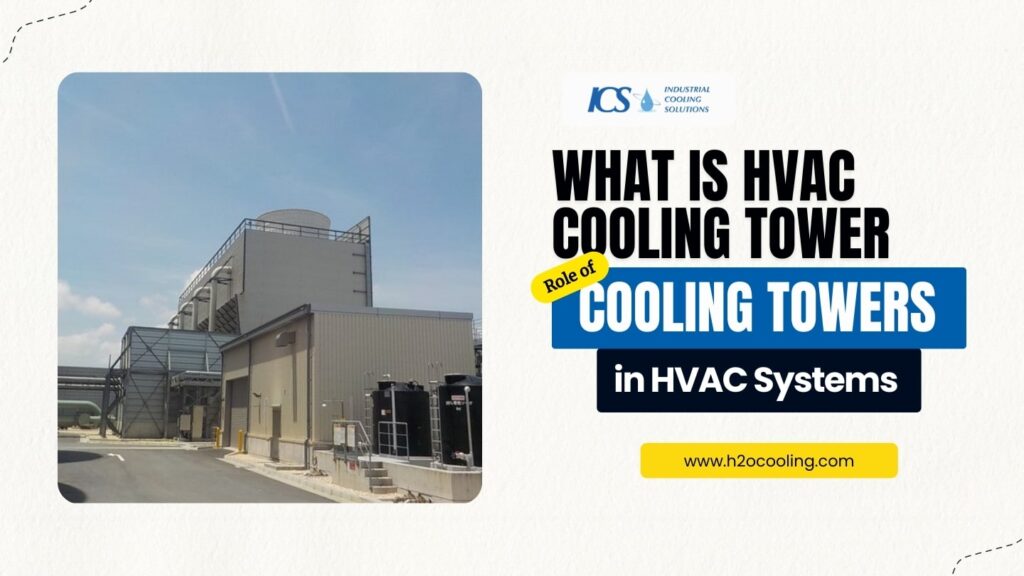HVAC systems depend on cooling towers, chillers, and Air Handling units to maintain the temperatures and humidity inside the buildings. They are necessary for commercial buildings like hospitals, offices, and shopping malls, keeping buildings cool and safe for people inside. Cooling towers extract extra waste heat from the building’s air conditioning system. With their impressive efficiency and versatility, modern commercial building designs have become essential to HVAC cooling towers.
This article will explore the fundamentals of HVAC cooling towers, their role, benefits, and essential types. You will also find the primary difference between chillers and cooling towers and determine the best option for your facility.
Table of Contents (HVAC Cooling Tower)
What is the HVAC System in the Cooling Tower?
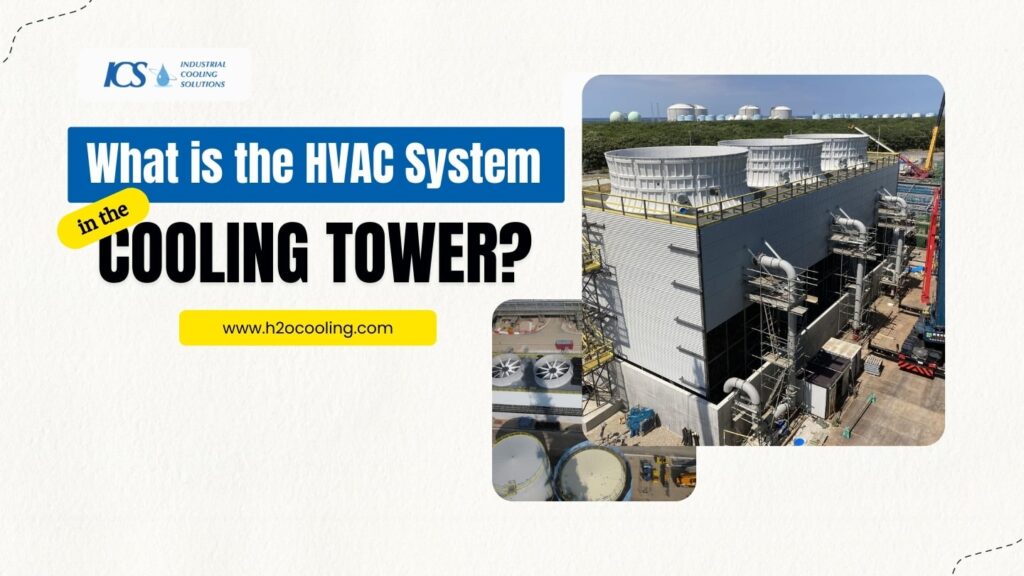
Heating, Ventilation, and Air Conditioning (HVAC) systems are widely used in industrial and commercial processes to maintain ideal indoor comfort and environmental quality. Cooling towers are the most critical part of these systems that play a crucial role in balancing the internal climates. Within a cooling tower, these systems perform three primary functions: circulating water, controlling temperature, and maintaining airflow.
Some of the critical components of this mechanical system in cooling towers are:
The hydraulic network consists of pipes, pumps, and regulatory valves that supply water to the cooling towers. This design ensures that water is evenly distributed throughout the building and allows optimal thermal diffusion.
Fans and Motors: These create airflow through the cooling towers. This gust is necessary for heat transfer, as it allows the water to be cooled by air.
Tower cells: These are modular units that contain the heat transfer media. It includes fill packs that are used to increase the surface area of the water and splash bars, which are necessary to distribute water evenly throughout the cooling tower.
Monitoring system: A management strategy that holds and regulates HVAC performance. It consists of sensors, actuators, and programmable logic controllers.
Role of Cooling Towers in HVAC System
Cooling towers play significant role in the HVAC system to ensure the maximum heat removal from the industrial hot water for an ideal and optimal performance. In HVAC, cooling towers, chillers, and Air Handling Units (AHUs) work together at the same time for maximum heat dissipation and air conditioning. Here are the most famous and practical roles of Cooling Towers in sizeable commercial HVAC systems.
Heat Dissipation
The primary role of a cooling tower in the HVAC is to remove waste heat through the evaporative cooling process. It also works as a heat exchanger in large commercial commercial buildings. The hot water from the industrial process enters the cooling tower system, and its distribution system ensures the smooth and even flow of water on the fill media by sharp spray nozzles in the form of droplets.
Here, cooling tower fans produce airflow, which results in the maximum heat exchange taking place between the dry air and the warm water. The water-air contact removes all the excess heat energy from the hot water; some water is lost as a result of evaporation, leaving behind the cold water, which gatherers at the bottom of the cold water basin or tower basin.
Integration with Chillers and AHU
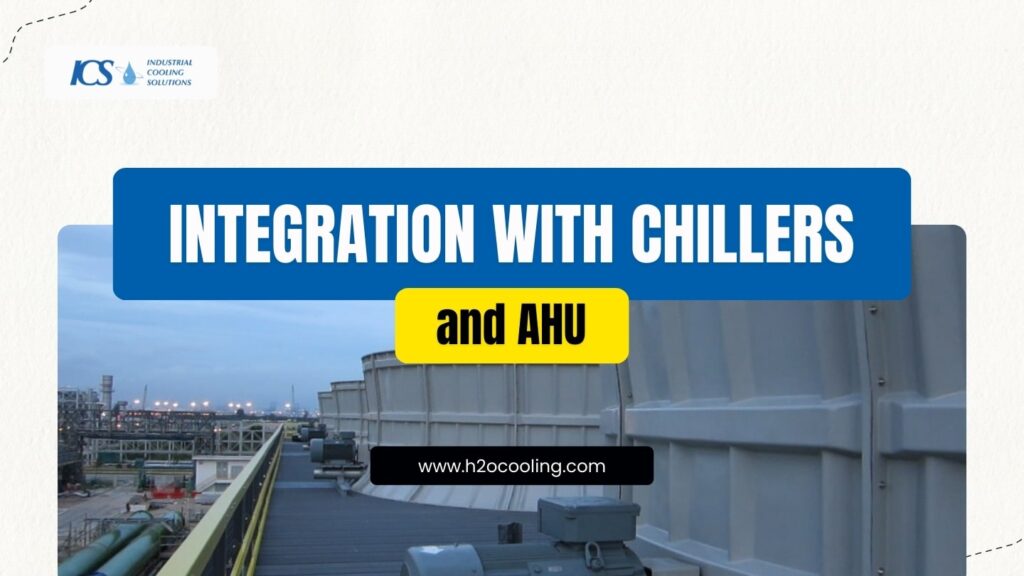
Cooling towers work with AHU and chillers for effective and potent cooling in chemical processing plants, food processing plants, thermal power plants, and other large buildings. Chillers withdraw excess and latent heat from the buildings and are directed toward the cooling towers.
The cooling tower extracts all the excess heat and colds the water; once chilled water is produced, it is supplied to the Air Handling Units (AHUs). These AHUs and fan coils further cool the air by pressing over the chilled water flowing in the cooling coil. This beneficial integration is vital for the optimal cooling process.
Maintain Optimal Temperature of Commercial HVAC
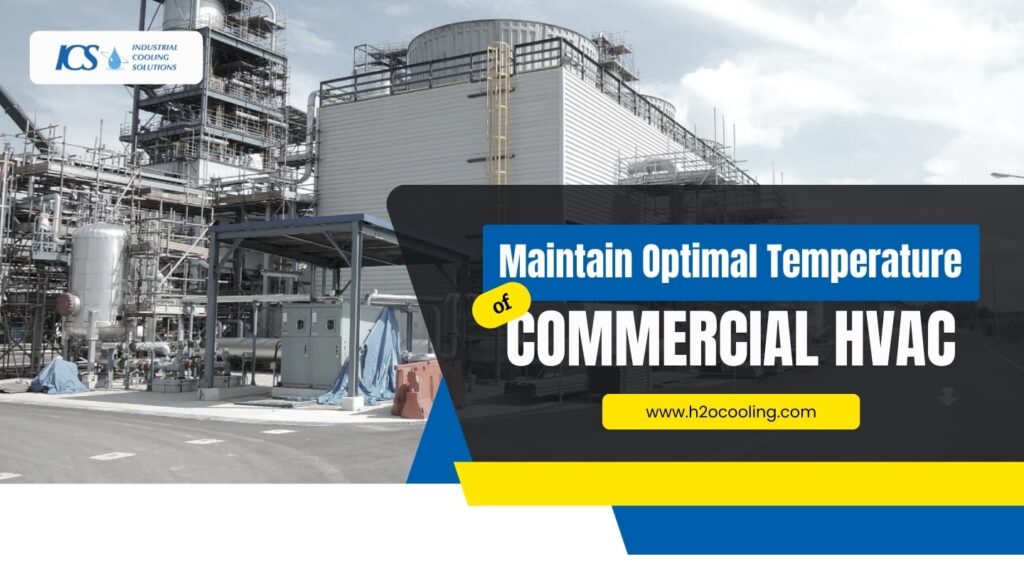
With continuous working and running of building machinery and equipment such as computers, AC, and other equipment, the temperature of the building increased drastically.
Cooling towers maintain the ideal temperature by acting as heat removal deceives for them, as the cooling towers absorb the excess heat. By continuously transferring heat, they regulate the inner temperature within the range for occupant comfort.
Enhance HVAC Component’s Lifespan
Large cooling tower plays a vital role in enhancing the lifespan of HVAC components by effectively removing waste heat and maintaining optimum temperature regularly 24/7. It is so evident that overheating can cause crucial wear and tear on the system parts, ultimately leading to the breakdown and costly repair of the expensive machinery.
Most Beneficial Types of Cooling Towers for HVAC Systems
The basic role of a cooling tower is to chill the water and dissipate the heat, but not all are constructed equal. There are different types, each delivering unique advantages, efficiencies, and applications.
Crossflow cooling towers: In this type, airflow is perpendicular to the water gush. It is suitable for small applications. The water distribution system is typically located above the fill pack, and the air intakes are on the tower’s sides.
Forced draft cooling towers: Fans push air through the tower, creating the forced draft. Forced draft towers type is suitable where space is limited. The lovers are typically found at the base of the tower, and the air is pushed upwards through the fill pack.
Open-circuit cooling towers: They are also known as wet towers, in which water is exposed to the air for maximum thermal exchange. It is mainly used for commercial processes and extensive facilities.
Counterflow Cooling Towers: In this, water and air move in opposite directions. It is also suitable where space is limited. The water distribution system is typically above the fill pack, and the air intakes are at the base.
Natural draft cooling tower: Natural draft cooling towers use raw convection to create a current, eliminating the need for fans for heat absorbed. This cost-effective and efficient design is suited for broad applications. The natural draft tower shape creates a pressure difference between the base and top, drawing air upwards through the tower.
Induced draft cooling tower: This type uses blowers to pull air through the tower and create an induced waft. The fans of the induced draft towers are located at the top of the building, and the air is pulled upwards through the fill pack.
Why are Cooling Towers Necessary for Commercial HVAC Systems?
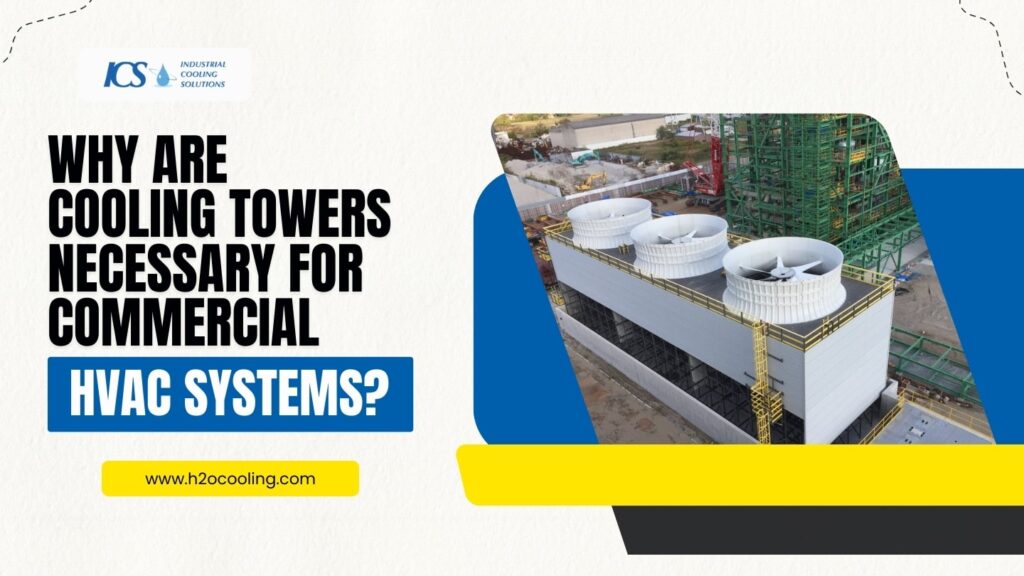
There are multiple benefits of cooling towers in the commercial HVAC system. From energy efficiency to reduced environmental impact and improving air quality to decreasing additional stress on the HVAC system, cooling towers are closely related to the HVAC system.
Energy Efficiency and Conservation
As HVAC has widespread applications and uses, it is used in hospitals, schools, petrochemical plants, factories, and residential homes. Commercial cooling towers rely on evaporation cooling techniques; they’re far better and more energy-efficient than the traditional HVAC system.
Natural evaporation cools the air naturally and quickly, decreasing the need for complex and expensive electrical cooling systems. Hence, HVAC cooling towers are more energy-efficient and lower energy bills.
To Overcome the Stress on The HVAC System
An overheated and overworked HVAC system can break down and need wear and tear, resulting in higher repairing costs, increased energy bills, and a shortened lifespan of HVAC equipment. Cooling towers take the heaviest load from the HVAC and lessen the unnecessary stress, ensuring maximum working efficiency.
Reduced Environmental Impact
According to the latest report of the NREL (National Renewable Energy Laboratory), air conditioning systems, cooling buildings, and refrigeration systems release more than 1950 million tons of CO₂ (Carbon Dioxide) and 3.945% of greenhouse gas emissions annually.
This situation is drastically alarming, as numbers are increasing rapidly with every single passing day. Large cooling towers have a small carbon footprint; hence, they emit fewer greenhouse gases and significantly alleviate the environmental impact.
Improved Air Quality
Cooling towers utilize the filtration process that prevents harmful contaminants and sediments from entering the HVAC’s air handling units. They are also helpful in maintaining the ideal humidity level by decreasing mould growth, hence improving indoor air quality.
Mould significantly decreases indoor air quality by releasing its tiny spores or grain into the air that can be inhaled. If these spores are inhaled by the building occupants, causing allergies, respiratory problems, and asthma.
Regular maintenance, use of water treatment chemicals and biocides, and the clean water recirculation of the cooling water can remarkably improve the overall air quality.
Cooling Towers vs. Chillers: Which one is Best for HVAC?
Regarding cooling applications, two main options, cooling towers and chillers, play an essential part in Heating, Ventilation, and Air conditioning. Both systems have their advantages and shortcomings. The choice between them depends on several factors, including the size and type of the building, climate, and chilling requirements.
Cooling Towers
These specialized heat exchangers use evaporation to cool fluids. They are commonly used in large commercial and industrial applications, such as power plants, high-rise buildings, and manufacturing facilities. They use water and air to remove heat and keep their efficiency. These factors make it cost-effective, more energy efficient, and easy scalability.
Disadvantages:
Water Consumption: Cooling towers require a large amount of coolant to operate, which can be a concern in areas with limited resources.
Noise and Space Requirements: These towers produce noise while they are working. For example, fans are used to moving air through the building, and they can be pretty loud, especially at high speed. Similarly, motors that drive fans can also be noisy, adding to the overall racket.
Other than these, they can be quite large, requiring significant space to install and operate. It can be a primary concern in urban areas where space is limited.
Chillers
These are machines that use a refrigerant to cool water or air. They are primarily used in smaller commercial and residential applications due to their compact designs, such as hotels, office buildings, and homes. They are flexible in their work, like they use for heating and cooling applications.
One significant advantage is they don’t require a large amount of water to operate, hence being best for areas with limited water resources. However, some penalties are associated with chillers, such as they demand more energy and high maintenance to perform optimally compared to cooling towers.
Best option?
The choice between a cooling tower and a chiller depends on several factors, including cooling requirements, space, and building size and type. By evaluating these aspects, you can choose the most suitable system for their specific needs.
Factors to Consider While HVAC Installation

Installing HVAC in your home, school, hospital, or other commercial buildings is a big decision. You have to decide wisely what kind of ventilation, heating, and air conditioning system should be installed in your locality.
The top 6 factors to keep in mind while installing HVAC are as follows:
Space Requirement: HVAC requires abundant initial, thermal upgrading, and maintenance space. Cooling towers also need ample space for a complete electrical and plumbing system. That is why most of the cooling towers are ideally installed on the roofs, as there is enough space. However, you can consult with professionals like ICS for the cooling tower design and space to tailor your needs.
Available Water Quality: Pure and high-quality water with an ideal pH range is the backbone of commercial cooling tower systems. Ensure you have a regular supply of quality water for maximum cooling efficiency and working ability.
Location Climate: What kind of HVAC should be installed depends on the climate conditions and environment. You can choose the HVAC unit with high ratings in terms of HSPF (Heating Seasonal Performance Factor) and SEER (Seasonal Energy Efficiency Ratio).
Ductwork Design: It is crucial to deliver the cooled air and heated air from your HVAC to the multiple areas or rooms of your office, home, or building. Your ductwork should be installed appropriately for effective cooling in summer and heating in the cold climate.
Budget: How much can you spend installing the HVAC in your space? Well, it totally depends on your budget. Have a list of the latest prices of all kinds and sizes of HVAC and narrow it down based on your budget. It will surely help you to decide the best one for you.
Maintenance Plan: Consider choosing the HVAC with years of maintenance plan and warranty for smooth and comfortable temperature control. Extended warranties give you peace of mind and relaxation because your investment is protected. You can contact these manufacturers if you have any difficulty.
Conclusion
HVAC cooling towers are a basic necessity and an intelligent investment in today’s world in terms of providing comfort. They are more effective, energy-efficient, and intelligent for providing the utmost cooling efficiency. These cooling towers have lower carbon prints, making them best for supporting quality air and reducing environmental impact.
On the other hand, a cooling tower needs vast spaces, regular maintenance, quality water supply, and routine checkups for consistent cooling. Above, we have discussed the top role, benefits, types of cooling towers, and factors to consider while installing new HVAC.
Need a cooling tower expert to install a new tower system, buy new cooling tower components, or do maintenance? Contact ICS for quality services.

